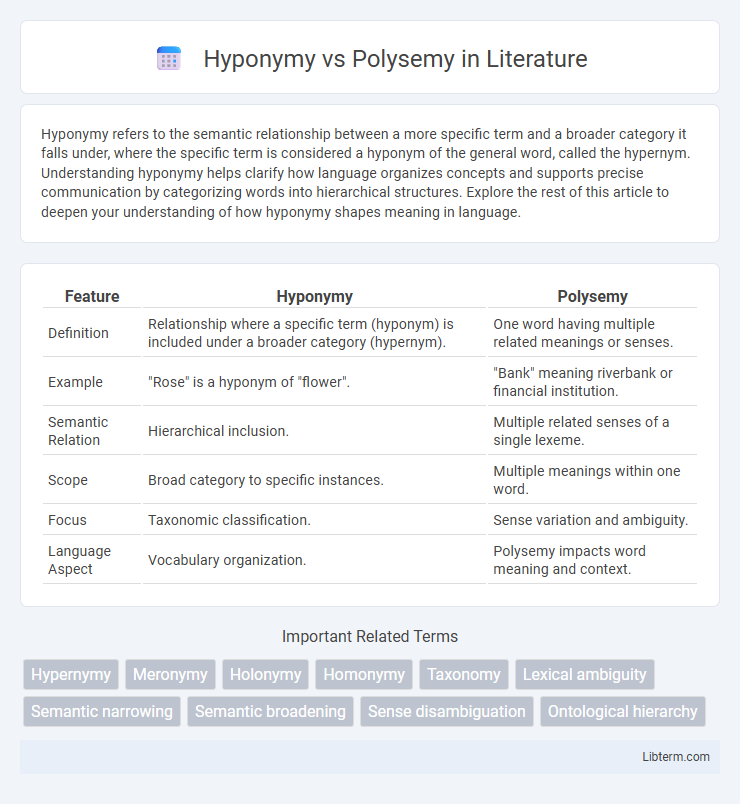Hyponymy refers to the semantic relationship between a more specific term and a broader category it falls under, where the specific term is considered a hyponym of the general word, called the hypernym. Understanding hyponymy helps clarify how language organizes concepts and supports precise communication by categorizing words into hierarchical structures. Explore the rest of this article to deepen your understanding of how hyponymy shapes meaning in language.
Table of Comparison
| Feature | Hyponymy | Polysemy |
|---|---|---|
| Definition | Relationship where a specific term (hyponym) is included under a broader category (hypernym). | One word having multiple related meanings or senses. |
| Example | "Rose" is a hyponym of "flower". | "Bank" meaning riverbank or financial institution. |
| Semantic Relation | Hierarchical inclusion. | Multiple related senses of a single lexeme. |
| Scope | Broad category to specific instances. | Multiple meanings within one word. |
| Focus | Taxonomic classification. | Sense variation and ambiguity. |
| Language Aspect | Vocabulary organization. | Polysemy impacts word meaning and context. |
Introduction to Hyponymy and Polysemy
Hyponymy refers to the semantic relationship where a specific term (hyponym) is included within a broader category (hypernym), such as "rose" being a hyponym of "flower." Polysemy occurs when a single word possesses multiple related meanings, like the word "bank" referring to both a financial institution and the side of a river. Understanding hyponymy and polysemy is essential for natural language processing tasks, including word sense disambiguation and lexical semantics.
Defining Hyponymy: Meaning and Examples
Hyponymy refers to a semantic relationship where the meaning of one word (the hyponym) is included within the meaning of another, more general word (the hypernym), such as "rose" being a hyponym of "flower." This hierarchical structure allows for precise categorization and organization of vocabulary by specifying subtypes within broader categories. Examples include "poodle" as a hyponym of "dog" and "oak" as a hyponym of "tree," illustrating the nested relationship between general and specific terms.
Understanding Polysemy: Concept and Illustrations
Polysemy refers to a single word having multiple related meanings, such as "bank," which can mean a financial institution or the side of a river. This linguistic phenomenon illustrates how one term can develop various senses linked by an underlying concept, enriching language complexity and context interpretation. Understanding polysemy aids in natural language processing by improving word sense disambiguation and semantic analysis.
Linguistic Significance of Hyponymy
Hyponymy plays a crucial role in lexical semantics by establishing hierarchical relationships between general and specific terms, enabling efficient categorization of vocabulary within languages. This hierarchical structure aids in natural language processing tasks such as word sense disambiguation and ontology building by clearly defining semantic fields. Unlike polysemy, which deals with multiple meanings of a single word, hyponymy provides a systematic framework for understanding semantic inclusion and class membership among lexical items.
The Role of Polysemy in Language Structure
Polysemy plays a crucial role in language structure by enabling a single word to possess multiple related meanings, which enhances linguistic economy and cognitive efficiency. Unlike hyponymy, which establishes hierarchical relationships between general and specific terms, polysemy reflects semantic flexibility within a single lexical item, allowing context to determine meaning. This dynamic interaction supports nuanced communication and contributes to the richness and adaptability of natural language semantics.
Key Differences between Hyponymy and Polysemy
Hyponymy involves a hierarchical relationship where a hyponym is a more specific term within the category of a hypernym, such as "rose" being a hyponym of "flower." Polysemy occurs when a single word has multiple related meanings, like "bank" referring to both a financial institution and the side of a river. The key difference lies in hyponymy representing a class-subclass relationship between different words, while polysemy involves multiple meanings of the same word.
Common Confusions: Hyponymy vs Polysemy
Hyponymy involves a hierarchical relationship where a specific term (hyponym) falls under a broader category (hypernym), such as "rose" being a hyponym of "flower." Polysemy occurs when a single word has multiple related meanings, like "bank" referring to both a financial institution and the side of a river. Common confusions arise because both deal with word meanings, but hyponymy is about class inclusion, whereas polysemy is about a single word having different senses.
Practical Applications in Lexicography
Hyponymy plays a crucial role in lexicography by enabling hierarchical organization of vocabulary, where specific terms (e.g., "rose," "tulip") are classified under broader categories (e.g., "flower"), facilitating efficient dictionary structuring and semantic search. Polysemy involves words with multiple related meanings, requiring lexicographers to carefully distinguish senses within dictionary entries to improve clarity and usability for language learners and NLP applications. Practical applications include enhancing thesaurus databases and semantic networks, which support better word sense disambiguation and improve machine readability in lexical resources.
Impacts on Language Processing and Semantics
Hyponymy, where a specific term (hyponym) falls under a broader category (hypernym), enhances hierarchical organization in semantic networks, facilitating more accurate context-based language processing and efficient information retrieval. Polysemy, involving multiple related meanings for a single word, poses challenges for natural language understanding algorithms due to ambiguity, requiring sophisticated disambiguation techniques to interpret meaning correctly in varying contexts. Both phenomena significantly influence semantic analysis, impacting tasks such as word sense disambiguation, ontology development, and machine translation accuracy.
Conclusion: Distinguishing Hyponymy from Polysemy
Hyponymy involves a hierarchical relationship where a hyponym denotes a subclass within a broader category represented by its hypernym, such as "rose" being a hyponym of "flower." Polysemy occurs when a single word possesses multiple related meanings, like the word "bank" referring to both a financial institution and the side of a river. Distinguishing hyponymy from polysemy is crucial for semantic clarity, as hyponymy reflects categorical inclusion while polysemy illustrates semantic multiplicity within a single lexical item.
Hyponymy Infographic

 libterm.com
libterm.com